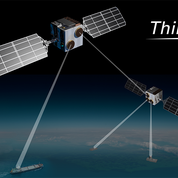ThinKom Unveils New VICTS Antennas for Space Payloads
ThinKom Solutions today announced the development of a new family of phased-array antennas for deployment on satellites and other space vehicles.
The antennas are based on ThinKom’s proven VICTS (Variable Inclination Continuous Transverse Stub) technology. The multi-frequency full-duplex antennas are designed for operation on geostationary and non-geostationary satellites using C-, X-, Ku-, Ka-, Q-, V-, E- and W-band frequencies. They can provide steerable high-capacity inter-satellite links as well as space-to-earth and Earth-to-space feeder and user links.
The new ThinKom payload antennas are compact and lightweight, with a 30-cm diameter antenna weighing less than 5 kg. They can be nested for multi-beam applications without the blockages that can occur with multiple parabolic dish arrays. They can also support digital beamforming within regional user beams.
The space payload VICTS antennas are designed with an aluminum structure and space-compatible components to function reliably under extreme conditions of radiation, shock, vibration, and temperature. The compact highly reliable conformal arrays do not require any post-launch deployment mechanisms, eliminating the added weight and complexity of traditional satellite antenna systems.
The high-efficiency VICTS antenna architecture enables a smaller mounting size and volume for a given level of performance, as well as lower inertia than traditional satellite designs. The result is extremely low power consumption, a critical requirement for space applications.
Other key features include 80-degree scan angle coverage, wide instantaneous channel bandwidth up to 2 GHz, polarization diversity, low sidelobe emissions, and continuous jitterless high-agility scanning.
“For space-based applications, long-term dependable and maintenance-free performance is a no-compromise requirement,” said Bill Milroy, CTO, and chairman of ThinKom Solutions. “Our highly reliable VICTS platform has been thoroughly field-proven with thousands of units already deployed in aero, land, and maritime mobile environments, across more than 23 million cumulative hours of service.”
“We believe our space payload antennas hit the ‘sweet spot’ between the bulkier and heavier gimbaled dish antennas, with their deployment and kinematic complexities, and the less efficient power-hungry electronically steered arrays (ESAs),” Milroy added. “A 30-cm VICTS antenna only requires a small fraction of the power and area required for a comparable performing ESA.”

